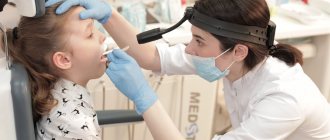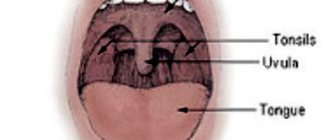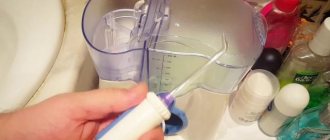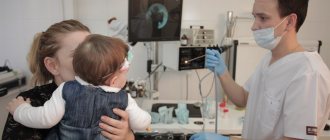What are lacunae
The tonsils are covered on the outside with a mucous membrane with depressions called lacunae. They protect the body from pathogens and ensure filtration of everything that enters the mouth.
In the follicles that make up the tonsils, lymphocytes mature and are released onto the surface of the lacunae to destroy microbes. In a healthy person, the lacunae cleanse themselves.
Who's at risk
The following are primarily susceptible to the disease:
- Children are carriers of pathogenic microflora. As soon as favorable conditions for the disease occur (for example, during hypothermia), the bacteria are activated. An inflammatory process occurs. The main causative agent of sore throat is considered to be β-hemolytic streptococcus of group A or B.
- Malnourished children. An unbalanced diet, lack of essential vitamins in the diet, and, as a consequence, low body weight - all this inevitably leads to a weakening of the children's immune system.
- Children with congenital or acquired immunodeficiency conditions, when the body is not able to produce the required number of immune cells to fight viruses.
- Children experiencing frequent hypothermia. Low temperatures are always stressful for the body, especially for children. In such tense conditions, he cannot work fully. As a result, the smallest amount of bacteria becomes enough to cause disease.
- Children with existing chronic diseases of the oro- and nasopharynx: caries, stomatitis, sinusitis, etc.
- Children with allergies
Why is rinsing prescribed?
When immunity decreases, the production of lymphocytes decreases, and an inflammatory process begins in the lacunae. As a result of the disease, the ability to cleanse itself decreases and the recesses of the tonsils become clogged with purulent plugs.
The person’s health deteriorates and the following appears:
- heat,
- severe sore throat
- difficulty swallowing.
With frequent such manifestations, doctors diagnose chronic tonsillitis. And rinsing is prescribed to prevent the spread of infection to other organs.
This stops the exacerbation of tonsillitis and in some cases eliminates the need for surgical intervention to remove the tonsils. Washing is almost painless, as doctors use modern equipment to carry it out quickly.
Important! It is dangerous to clean lacunae on your own due to the risk of damaging the delicate mucous membrane of the palate and pharynx.
Features of each technique
Despite the fact that the use of a syringe can significantly reduce the cost of treating the infected area, the method also has several significant disadvantages. The most important of them is the increased risk of injury, since if the doctor lacks experience, there is a high risk of causing microtrauma with a metal cannula.
If the doctor accidentally made a puncture, then this will result in prolonged healing, which, against the background of a general infection, will generally occur extremely slowly. A scar remains as an eternal reminder, which during the next exacerbation of chronic tonsillitis will become a significant obstacle to the outflow of fluid.
It turns out to be a vicious circle: the patient will get sick again, will come to the appointment again for syringe rinsing due to the inability of the tonsils to independently organize the outflow of fluid. Thus, even initially, for the first time, people who become ill can enroll in the circle of chronic patients.
Another difficulty may be the anatomical structure of the treated area. Due to the tortuosity, reaching all corners of the curved passages will be quite problematic. This increases the percentage probability that the infection will remain stuck for a long time at a practically inaccessible point, constantly making itself known after the condition has partially improved.
Against this background, many victims choose a hardware approach, which involves a higher cost. It also has a number of contraindications, among which pregnancy is especially prominent. When a woman in an interesting situation becomes a victim of a sore throat, she will be sent for treatment using syringe rinses that are safer for the fetus.
At the same time, vacuum intervention is ready to provide a more sustainable effect compared to its outdated counterpart. The method also allows you to almost completely eliminate the risks of a possible accidental puncture of part of the larynx. Regardless of the chosen measure, it is imperative to pay attention to the absolute prohibitions for implementing manipulation. These include:
- acute infectious diseases with elevated body temperature;
- oncological neoplasms of any location;
- tuberculosis.
A relative contraindication would be those people whose gag reflex is pronounced. If you manage to endure it the first time, then, as reviews indicate, in subsequent times the deficiency manifests itself much weaker.
Types of washing
Purpose of appointment: to remove pus from the lacunae and treat them with a drug. After this, the patient's condition improves significantly.
Specialists carry out the procedure in different ways:
syringe. A solution is drawn into a 20-gram syringe. Instead of a needle, a special nozzle with a curved end is put on so that the solution falls directly on the stopper. The liquid under the pressure of the piston is fed into the lacuna and flushes it.
Washing the tonsils- Vacuum method of washing tonsils . The tonsils are anesthetized, a vacuum suction cup is attached to them, through which the purulent contents are pumped out. After this, the medicinal composition is pumped into the lacuna.
- Ultrasonic washing of tonsils . The cleaning principle is based on a combination of cavitation and ultrasound. Air bubbles form in the washing liquid, and when they rupture, the membranes of microbial cells are damaged.
The Kuntsevo Medical Center has modern otolaryngological equipment, which allows the operation to be performed as quickly, efficiently and painlessly as possible.
How to rinse tonsils at home?
There are several ways to cleanse the recesses in the tonsils on your own. These include:
- rinsing;
- eliminating purulent plugs using cotton swabs and disks;
- treatment with a syringe (without a needle);
- use of an irrigator.
The main requirement before using the above procedures is to visit an ENT doctor who will instruct the patient on the nuances of treatment. Incorrect therapy at home will lead to deterioration of health, injury to soft tissues, and accelerated spread of pathogens.
When planning to carry out any therapeutic manipulations, wash your hands thoroughly with soap!
Before treatment, it is recommended to watch a video about washing the tonsils:
Rinse
This type of cleaning is suitable for removing plaque formed in the initial stage of the disease. His technique is simple: just take the medicinal solution into your mouth, and, throwing your head back, rinse the mucous membranes.
Herbal mixtures used for treatment should be warm; antiseptics - at room temperature.
Rinsing duration is at least 3 minutes. Frequency - at least 8 times a day.
Trying to wash the lacunae of the tonsils at home by rinsing is not advisable: medicinal solutions only affect the outer part of the tonsils, while the plugs are located deep in the lymphoid tissue.
Washing tonsils at home using cotton pads and swabs
These washing methods consist of two stages:
- cotton pads/sticks are moistened with a disinfectant solution;
- problem areas are wiped with gentle movements.
A cotton swab is quite convenient for removing loose deposits at home.
: to remove the plugs from the recesses of the tonsils, you need to lightly press on the tonsils below the location of the purulent formation.
Using a syringe
Before you rinse your tonsils at home using a syringe, you need to prepare a solution of furatsilin (the principle of preparing a disinfectant liquid is discussed below). The throat is gently irrigated from a medical instrument.
You should rinse the lacunae with a syringe in front of a mirror.
It is forbidden to swallow the liquid after completion of therapy - it contains pathogens washed off from the surface of the tonsils.
It is recommended to wash the tonsils in this way at least 5 times a day.
Using the irrigator
The device used for treatment is called a “laryngeal” syringe. Its main difference from a conventional medical instrument is its elongated curved tip. Only a doctor will give a detailed answer to the question of how to wash your tonsils at home using an irrigator. The treatment process can be briefly described as follows:
- The syringe is filled with a medicinal substance.
- The nozzle is carefully inserted into the tonsil lacuna.
- The recesses are washed by pressing the piston of the device.
Cleaning is carried out from 1 time per day.
The disadvantages of using an irrigator include the risk of injury to the lacuna and the possible pushing of plugs deeper into its tissue.
How is the procedure performed?
All rinsing methods are based on exposing the tonsils to a stream of disinfecting solution or vacuum. Cleaned tonsils are treated with medications.
Processing each tonsil takes from 30 seconds to 1.5 minutes. The time depends on the choice of type of cleaning of the lacunae and the depth of damage to the lacunae.
Important! Before the procedure, you cannot eat for 1.5-2 hours. This is due to the fact that rinsing provokes a gag reflex.
To prevent possible discomfort, the doctor treats the tonsils with a local anesthetic with lidocaine or novocaine in the form of a spray.
Washing using the device – Tonsillor
The ultrasound device Tonsillor occupies the top positions in the treatment of tonsillitis. Ultrasonic waves promote better penetration of medicinal dissolved components very deeply into the tissue. They destroy purulent and protein formations, suppress inflammation, promote resorption and pain relief, and relieve spasms in blood vessels. With the help of a vacuum, excellent suction of the bad contents of the lacunae occurs, and injury to the tissues themselves during the procedure is eliminated.
The method has undeniable advantages:
- Unlike antibacterial drugs, bacteria do not and do not develop resistance to ultrasound.
- Thanks to specific nozzles, tonsils can be washed in a targeted manner. Ultrasound removes the bacterial component mechanically and promotes high-quality penetration of the medicine into the empty spaces of the tonsils from pus. Thanks to this duet, the effect of treatment increases many times over.
- The procedure takes little time and does not cause injury. The attachments cannot injure the oral mucosa, thereby eliminating the risk of infection entering the bloodstream. The device has attachments for treating children and adults.
- The drug is used both during remission and during exacerbation of the disease. The drug makes it possible to reduce the dose of antibiotics without causing allergic reactions or dysbacteriosis. Reduces treatment time and reduces the risk of complications and the spread of infections to neighboring organs.
- The only negative is that the drug is prohibited for use in the first 3 months of pregnancy.
Contraindications
Treatment of lacunae is not prescribed for patients with:
- exacerbation of other chronic diseases, including caries;
- cancer diagnoses;
- in the 1st and 3rd trimester of pregnancy;
- pathology of the retina;
- severe pathologies of the heart and blood vessels;
- up to 3 years of age.
For hypertension, consultation with a specialized specialist is required.
Important! It is necessary to warn the doctor about any existing individual intolerance to drugs.
What types of tonsils are there?
The tonsils are paired and unpaired. Paired tonsils are the palatine tonsils, the inflammatory process in which is called chronic tonsillitis, and we know an acute infectious disease as a diagnosis - “tonsillitis”. There are also tubal rollers or tubal tonsils. They border the entrance to the pharyngeal mouth of the auditory tube.
The unpaired tonsils include the pharyngeal and lingual tonsils. The growth of the pharyngeal tonsil is nothing more than the adenoids known to everyone. The lingual tonsil is located at the root of the tongue. The totality of all tonsils forms the Pirogov-Waldeyer lymphoid pharyngeal ring.
In newly born babies, the tonsils are still undeveloped, and only by two or three months do they begin to gradually perform their protective functions. Adenoids develop much more actively in early childhood. During this period, children are most susceptible to infections and diseases. Over time, the number of antibodies that are designed to fight bacteria grows, and by the age of nine to ten years, the lymphoid tissue of the adenoids decreases, and by the time the child reaches adulthood, small particles remain of it, or even disappear completely. The tonsils are fully developed in their development by the age of two. By the age of five to seven years, the tonsils reach their optimal size. Numerous vaccinations also contribute to the growth activity of the tonsils.
In our article we will talk directly about inflammation of the palatine tonsils and what methods exist for washing the palatine tonsils in children.
Recommendations after procedures
Rinsing the lacunae of the tonsils is a physical effect on the inflamed tissue, so after cleansing, discomfort and mild pain are possible.
You cannot eat immediately after the procedure, the first meal should not be earlier than 30 minutes later. It is necessary to regularly gargle with miramistin, furatsilin solution, infusion of chamomile, oak bark.
Washing the tonsils is not a very pleasant procedure, but it is done quickly. Its effectiveness has been proven by many years of use for the relief of chronic tonsillitis.
When is the procedure indispensable?
Doctors recommend using the presented method in the early stages of the disease, or if you notice signs of exacerbation of chronic tonsillitis. But if the situation has worsened, then auxiliary means alone for disinfecting the tonsils will no longer be enough. Doctors prescribe “heavy artillery” like strong antibiotics.
Content:
- When is the procedure indispensable?
- Classification of techniques
- Features of each technique
- How to achieve increased efficiency?
The main problem of those who constantly suffer from tonsil lesions lies in the inability to finally get rid of the accumulated painful microorganisms. They, together with dead leukocytes, are localized in the tortuous passages and voids of the organ. Most pathogens and dead leukocytes will not be able to get out of there on their own.
In particularly advanced cases, even the use of pharmacological drugs does not help, because pathogens, especially in chronic diseases, quickly get used to any active substance. Instead of killing germs, medications, at best, weaken their activity, as streptococci and staphylococci become resistant. You can get rid of them only through direct exposure, which is typical for washing the gaps. If the patient experiences weakness, sore throat, as well as discomfort in the cervical and submandibular lymph nodes during the next exacerbation, then this is a reason to undergo the procedure.
Adjuvant therapy often eliminates the need for victims to have their tonsils removed. But targeted treatment will help only in the absence of significant complications such as infection of internal organs. When pathogens enter the bloodstream, they often provoke the rapid development of cystitis, pyelonephritis and adnexitis, even faster than usual.
Preparing for vacuum rinsing of tonsils
To prescribe a course of washing the tonsils, you need to consult an otolaryngologist, who will perform an examination and, possibly, give a referral for a number of examinations:
- general blood analysis;
- examination of the microflora of the tonsils for bacterial damage;
- rheumatic tests to determine the intensity of inflammation and the risks of developing complications of tonsillitis in other organs.
In order for the vacuum cleaning session of the tonsils to take place without any excesses from the gastrointestinal tract, doctors strongly advise not to eat 3 hours before the start of the procedure. The fact is that the risk of a gag reflex, although reduced due to the anesthetic, still does not disappear completely. You will receive more detailed recommendations when making an appointment by phone.
Effects of hardware washing of tonsils
In most cases, a course of rinsing the tonsils with the Tonsillor apparatus is effective in several ways:
- powerful antibacterial effect, expulsion of pathogenic bacteria and toxic waste from the ENT organs being sanitized, normalization of the microflora of the oral cavity;
- intensification of the process of penetration of drugs deep into the tonsils;
- activation of local blood circulation, metabolism, nutrition and restoration of lymphoid tissue of the tonsils at the cellular level;
- anti-inflammatory effect;
- inclusion of local immunity.
“Cuckoo” or nasal lavage using the Proetz fluid movement method
A method developed by American otorhinolaryngologist Arthur Proetz more than a century ago. For many years it was used by ENT doctors to treat acute diseases of the nose and paranasal sinuses.
Russian ENT doctors prescribe “cuckoo” for almost any patient complaint, from acute rhinitis and sinusitis to acute adenoiditis and eustachitis. Washing technique: the patient lies on his back (less often sits), an antiseptic solution is pumped into one half of the nose, and removed from the other using suction. During the procedure, he is asked to pronounce the word “cuckoo” to reduce the likelihood of the solution getting into the throat and larynx (this causes the soft palate to rise, closing the nasopharynx). However, there is still a high risk of liquid entering the respiratory tract, especially in children who do not always understand what is required of them and behave restlessly.
Due to the creation of negative pressure in the nasal cavity, “cuckoo” can be traumatic for the inflamed mucous membrane of the nasal cavity, and if there is severe swelling in the nose and nasopharynx, it can be painful for the ears.
The use of “complex compounds” for rinsing is less preferable than saline solution. Antiseptics can additionally dry out the inflamed mucous membrane of the nasal cavity. Adding antibiotics to the solution also does not provide a therapeutic effect (in “cuckoo” it is often the reserve antibiotic dioxidine; its side effects are dangerous: experimental studies have shown that it has a mutagenic and damaging effect on the adrenal cortex). The addition of hormonal drugs such as dexamethasone or hydrocortisone is also not justified - there are more suitable hormones for use in the nasal cavity (mometasone, fluticasone, budesonide, etc.). If indicated, these sprays can be successfully used; however, they have low bioavailability, that is, they act only in the nose, without having a systemic effect on the body and without significant side effects.
It has been proven that nasal rinsing with positive pressure (Dolphin balloon, Neti pot) is more effective. Such rinses are especially effective for allergic rhinitis and chronic sinusitis.
Important to know : in acute bacterial sinusitis, it makes sense to discuss the use of oral antibiotics only. Neither topical antibiotics nor local antiseptics are indicated, even as an adjunct to treatment.
Signs of tonsillitis
The most reliable local signs of chronic tonsillitis are:
- Hyperemia and roller-like thickening of the edges of the palatine arches.
- Cicatricial adhesions between the tonsils and palatine arches.
- Loose or scarred and hardened tonsils.
- Caseous-purulent plugs or liquid pus in the lacunae of the tonsils.
- Regional lymphadenitis is an enlargement of the cervical lymph nodes.
The diagnosis is made in the presence of two or more of the above local signs of tonsillitis. In the compensated form, there are only local signs of chronic inflammation of the tonsils, the barrier function of which and the reactivity of the body are still such that they balance and even out the state of local inflammation, i.e. compensate for it, so a pronounced general reaction of the body does not occur.
In case of decompensation, there are not only local signs of chronic inflammation, but also tonsillitis, paratonsillitis, paratonsillar abscesses, diseases of distant organs and systems (cardiovascular, genitourinary, etc.)
Any form of chronic tonsillitis can cause allergization and infection of the entire body. Bacteria and viruses located in the lacunae under appropriate conditions (cooling, decreased body resistance, and other reasons) cause local exacerbations in the form of sore throats and even peritonsillar abscesses.
Rice. 1. Chronic follicular tonsillitis. Rice. 2. Chronic lacunar tonsillitis. Rice. 3. Chronic tonsillitis (Preobrazhensky sign). Rice. 4. Chronic tonsillitis (Gise’s sign)











